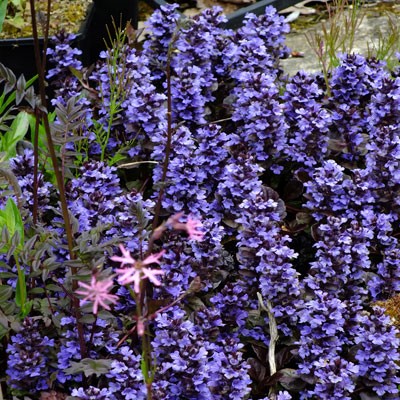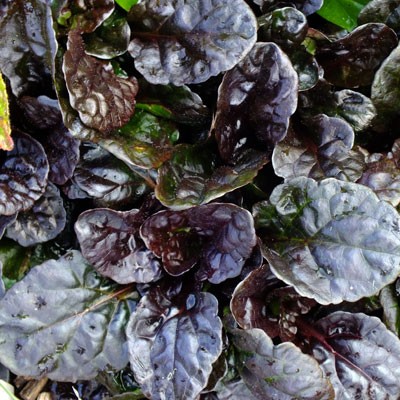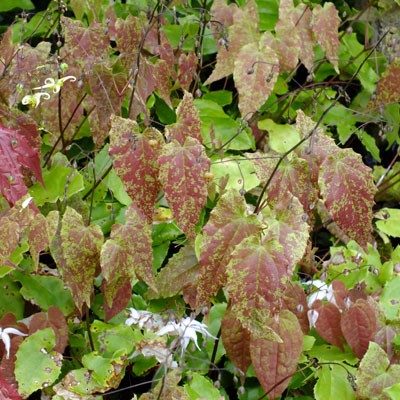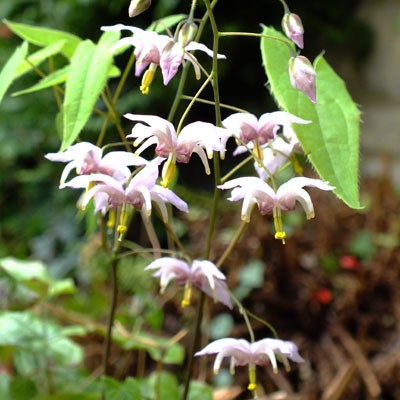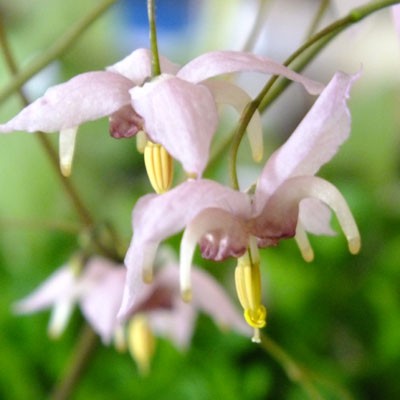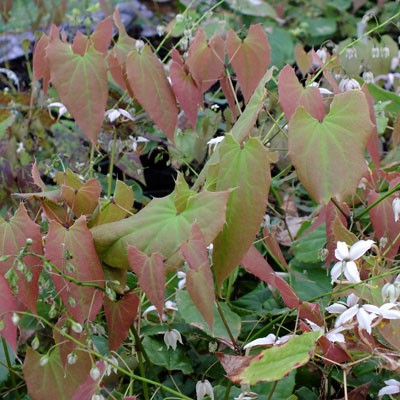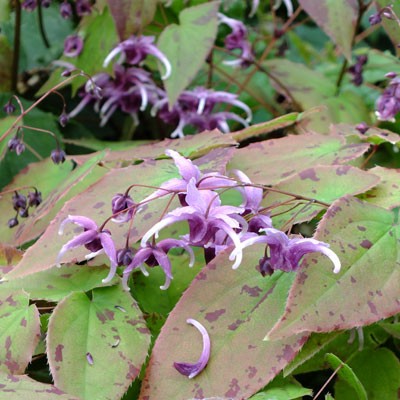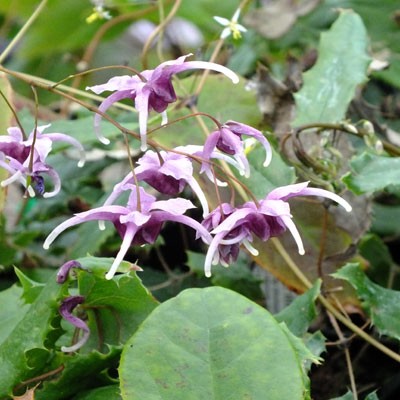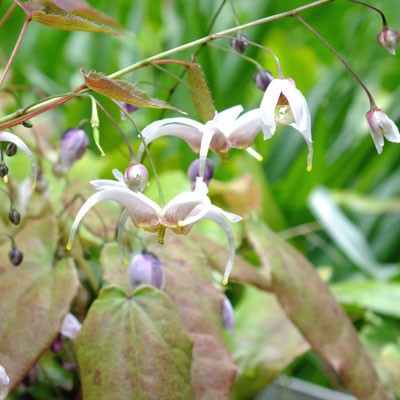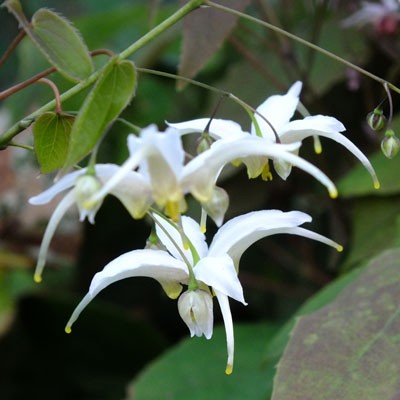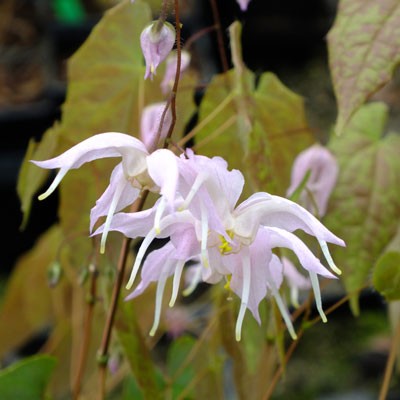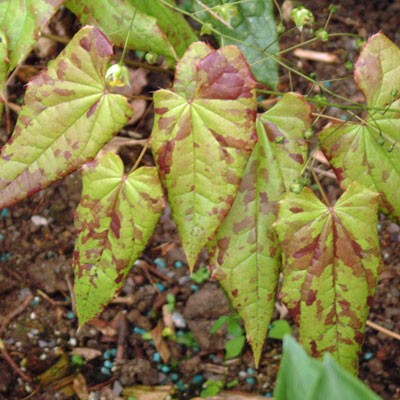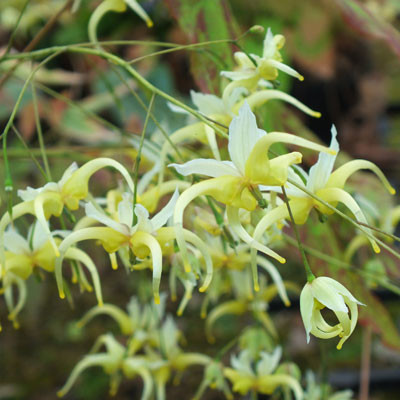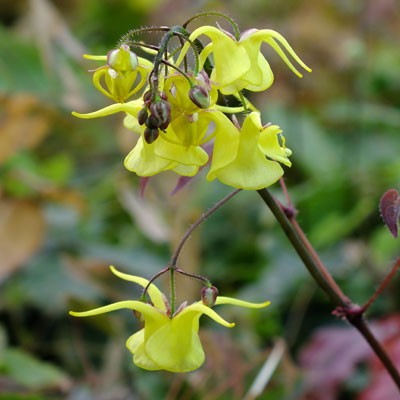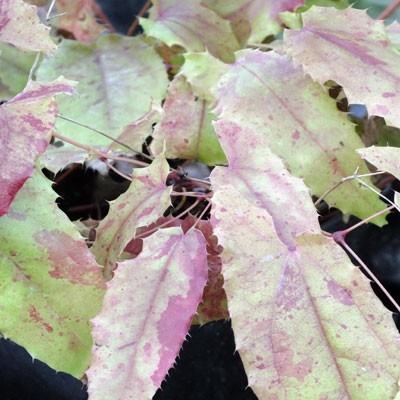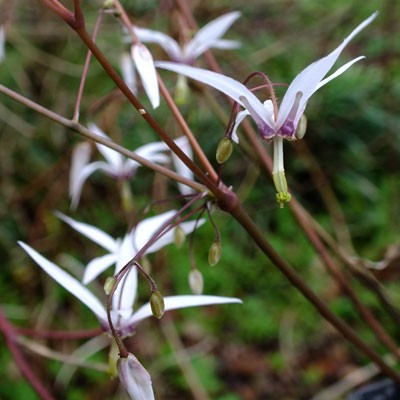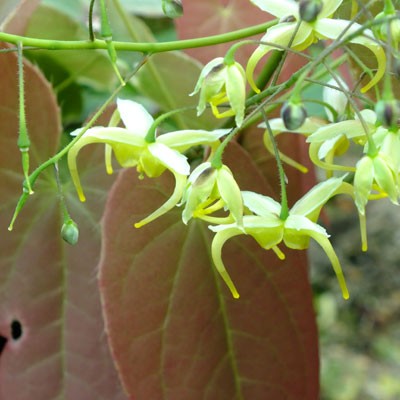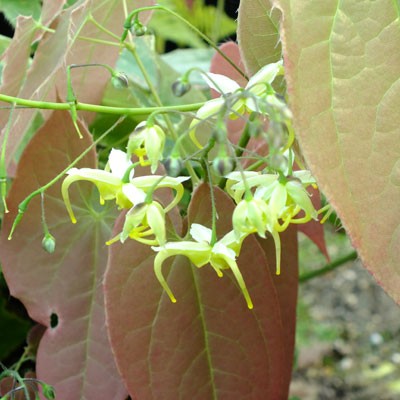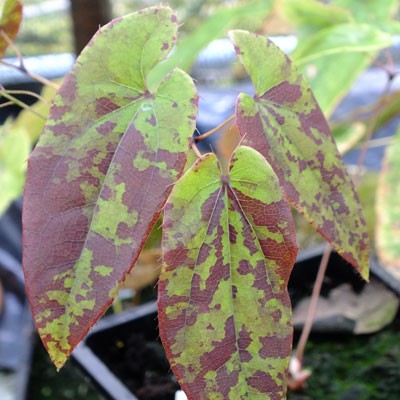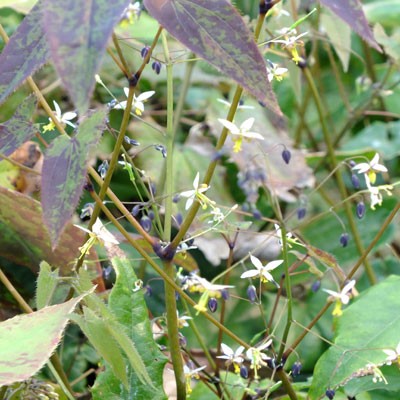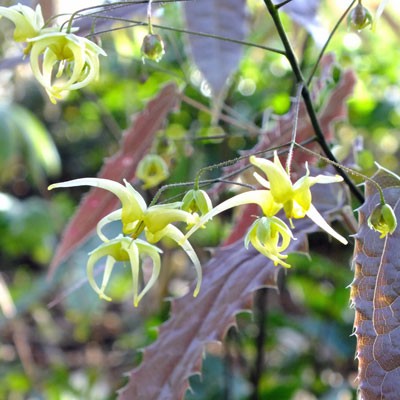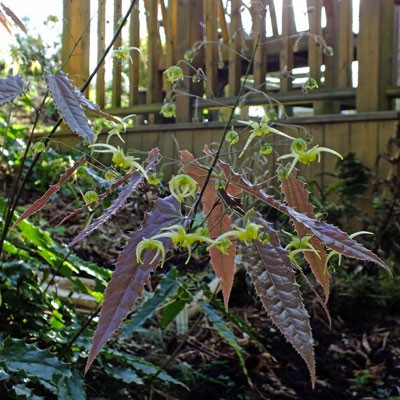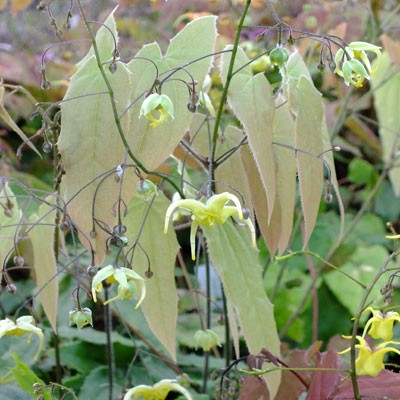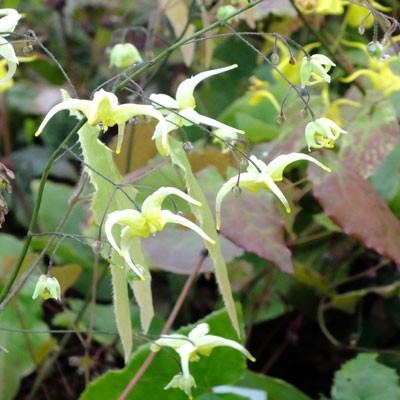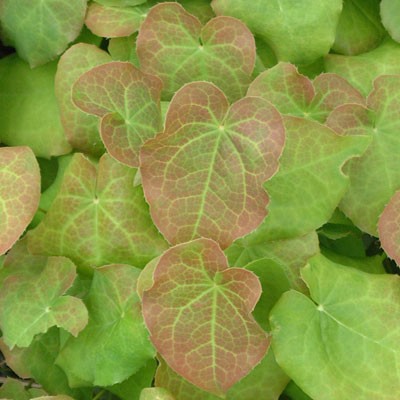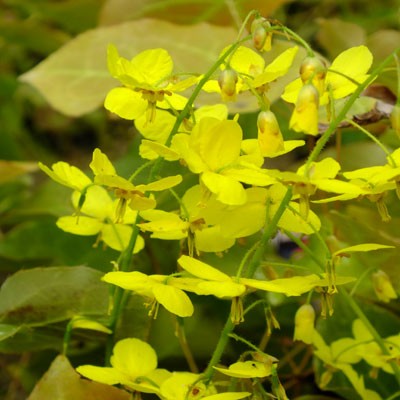-
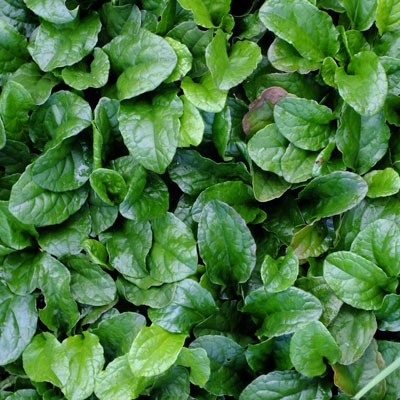

Potsize - 1L
Bugle. Lovely ground cover for a shady spot where the green leaves will make a dense carpet above which will stand dense, short spikes of pink flowers in the spring. Discount of 25p per plant for quantities of 3 or overLinks
Botanical Style Photographs
-
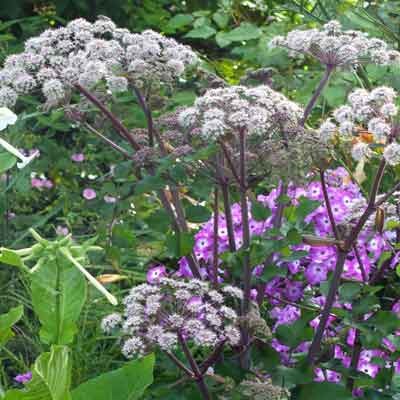
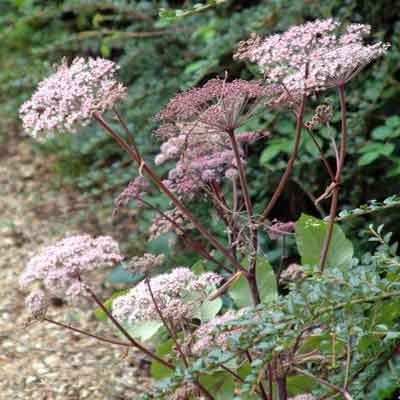

Bee Friendly
Potsize - 1L
Angelica sylvestris 'Purpurea' . Starting remarkably early in the year this plant pushes up fascinating glossy purple foliage, soon becoming an imposing architectural feature topped with a dense spherical head of pink flowers. In appearance not dissimilar to a more sturdy cow parsley, but with less air and more presence. Will seed about mildly. Likes a good moist spot. Discount of 25p per plant for quantities of 3 or overLinks
Umbellifers
-
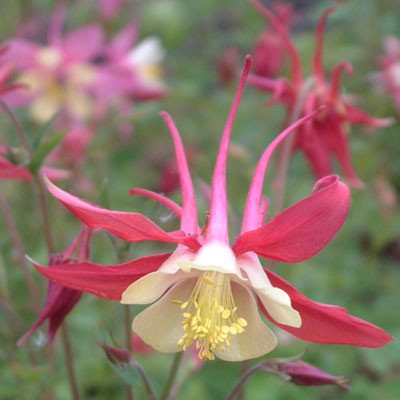
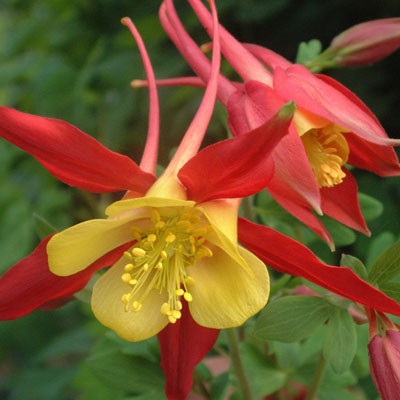
Potsize - 9cm
Aquilegia 'Koralle' An old cottage garden favourite and a good cut flower. Abundant display in late spring of long spurred red and yellow flowers over fine blue-green foliage. 80cm. Full sun. Medium height variety. A seed grown strain that might display some variation in colour and form. HARMFUL IF EATENDiscount of 25p per plant for quantities of 3 or more of this variety, 50p for 10 of any AquilegiaLinks
Aquilegia Compared
-


Potsize - 9cm
Aquilegia 'Yellow Star' (Star Series). An old cottage garden favourite and an excellent cut flower. Abundant display in late spring of long spurred two-toned lemon yellow flowers over fine blue-green foliage. Do not overcrowd the crown or allow other plants to flop over the foliage. 60cm. Full sun. HARMFUL IF EATENDiscount of 25p per plant for quantities of 3 or more of this variety, 50p for 10 of any AquilegiaLinks
Aquilegia Compared
-
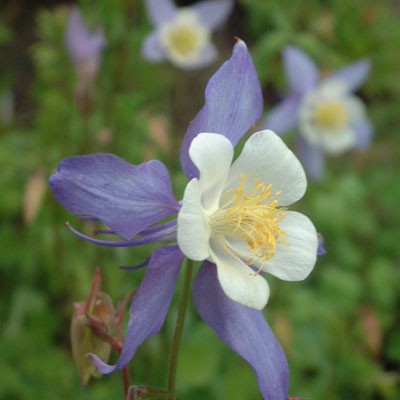

Potsize - 9cm
Aquilega 'Heavenly Blue' ('Sky Blue', 'Blue Dream'). A long spurred aquilega whose flowers are a rich cobalt blue with contrasting white corolla. A cottage garden favourite & an excellent and unusual cut flower. May to June. 85cm. A Medium height variety. allow some air around the crown. HARMFUL IF EATENDiscount of 25p per plant for quantities of 3 or more of this variety, 50p for 10 of any AquilegiaLinks
Aquilegia Compared
-
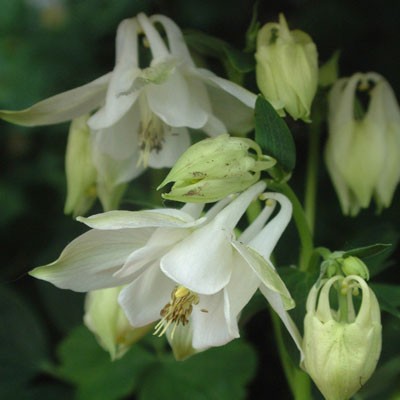
Potsize - 9cm
Large pure-white, gracefully nodding bonnets, each 4cm wide are borne on leafy stems 80cm high in great profusion. Often tipped with green on ageing, the spurs are short and slightly curled. The attractive divided foliage forms a basal clump of fresh apple-green, leafing up early in Spring to make a lovely foil for bulbs and early Primroses in the garden. They start pushing up flowering stems as early as April and go on producing a sequence of blooms until early June. They are deep rooted plants which seek water well and are therefore tolerant of dry shady conditions as well as full sun. The pure white blooms really lighten up a shady spot and look wonderful with cool greens and ferns. Although 'Munstead White' grows true from seed collected from isolated plants, Aquilegias are highly promiscuous members of the Ranunculaceae and will take any opportunity to mix their genes with their kin producing seedlings of a wide range of colours and spur lengths.Discount of 25p per plant for quantities of 3 or more of this variety, 50p for 10 of any AquilegiaLinks
Aquilegia Compared
-

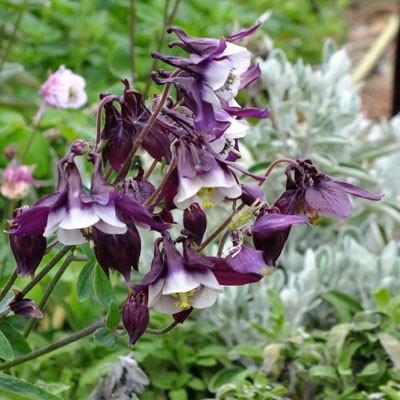
Potsize - 9cm
Aquilegia vulgaris 'William Guiness' ('Magpie') A recent introduction with striking flowers in bicolour white and deep purple (near black). The flowers are of traditional nodding A. vulgaris form with well flared petals and curve-tipped spurs. Would look good in a mixed cottagey border Best in light shade. 90cm HARMFUL IF EATENDiscount of 25p per plant for quantities of 3 or more of this variety, 50p for 10 of any AquilegiaLinks
Aquilegia Compared
-
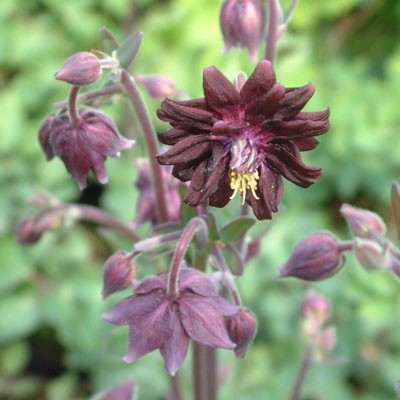
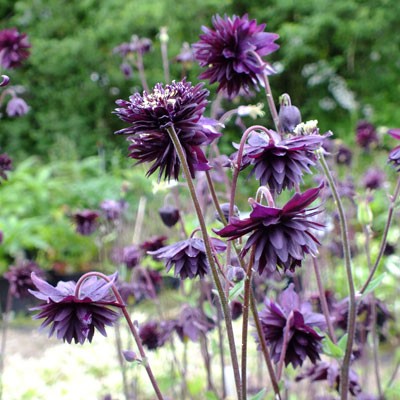
Potsize - 9cm
Aquilegia vulgaris var. stellata 'Black Barlow' (Barlow Series). One of the spur-less Barlow series based around the plant originally found in the garden of Nora Barlow. This form has flowers that are a deep dusky maroon. Would look good in a mixed cottagey border, hanging above paler mounds of flowers. Best in light shade. HARMFUL IF EATENDiscount of 25p per plant for quantities of 3 or more of this variety, 50p for 10 of any AquilegiaLinks
Aquilegia Compared
-
Sale!
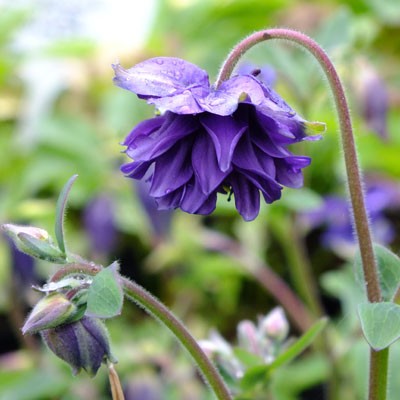
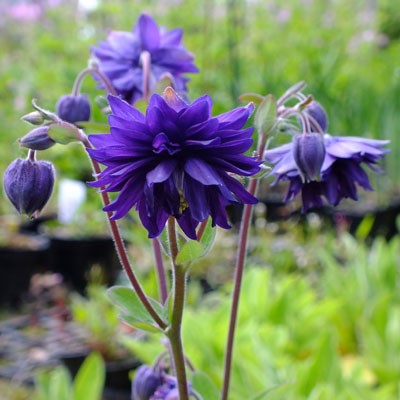
Potsize - 9cm
One of the spur-less Barlow series based around the plant originally found in the garden of Nora Barlow. This form has flowers that are a violet-blue. Would look good in a mixed cottagey border, hanging above paler mounds of flowers. Best in light shade. HARMFUL IF EATENDiscount of 25p per plant for quantities of 3 or more of this variety, 50p for 10 of any AquilegiaLinks
Aquilegia Compared
-

Potsize - 9cm
A fitting name for this richly claret coloured, very double. Spurless Aquilegia. A tall elegant variety with strong stems. 60-90cmDiscount of 25p per plant for quantities of 3 or more of this variety, 50p for 10 of any AquilegiaLinks
Aquilegia Compared
-
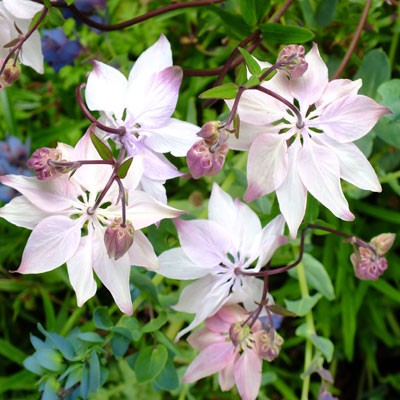

Potsize - 9cm
Aquilegia vulgaris var. stellata ( A. clematidiflora ). A variation on an old cottage garden classic. This is the root of all of those double flowered forms that you find under the 'Barlow' banner. It is a lovely thing, having quite flat flowers, lacking the usual Aquilegia spurs, and having more than a passing resemblance to a clematis. The stems are tall and all the pale fleshy-pink flowers look down so that you look on the backs of the flowers. easy and well worth squeezing into a mixed bed. Will freely seed about in any well drained soil and cheer any planting in late spring with its wonderful array of pastel flesh pink blooms. Any soil that is not too wet. full sun. 60cmDiscount of 25p per plant for quantities of 3 or more of this variety, 50p for 10 of any AquilegiaLinks
Aquilegia Compared
-
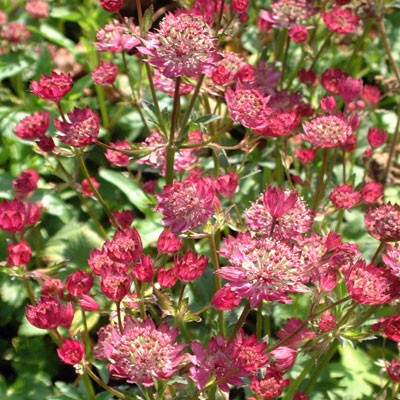
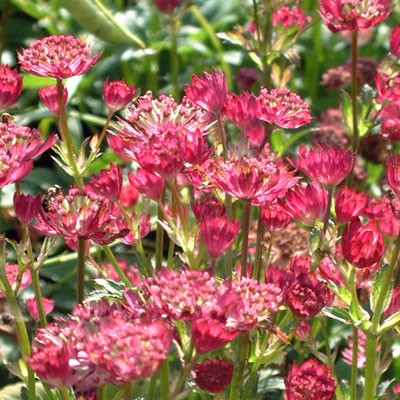
Potsize - 1L
A recently selected large flowered dark red masterwort. Tight clusters of maroon flowers are surrounded by beautiful ray florets. An interesting & beautiful plant happy in sun or part shade with some drainageLinks
Astrantia Compared
Astrantia in the Garden
Botanical Style Photographs
-
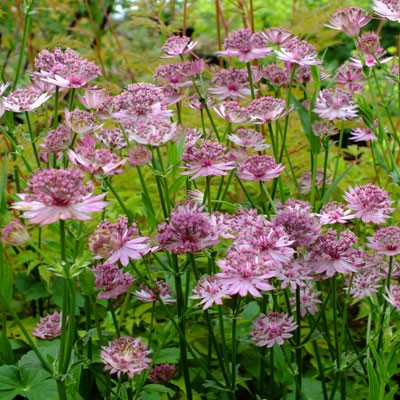
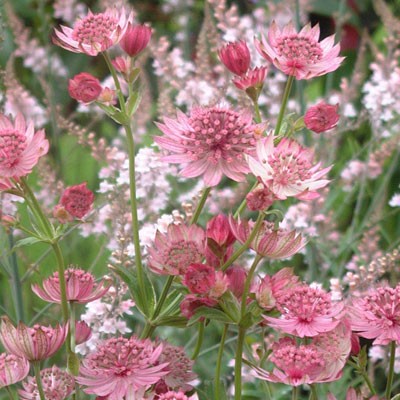
Potsize - 1L
Astrantia 'Roma'. Lovely mid pink cultivar of good constitution. The bracts form a shallow starry cup that is a shade lighter than the tight central pincushion of true flowers. 60cm. An interesting & beautiful plant Happy in sun or part shade with some drainageLinks
Astrantia Compared
Astrantia in the Garden
Botanical Style Photographs
-
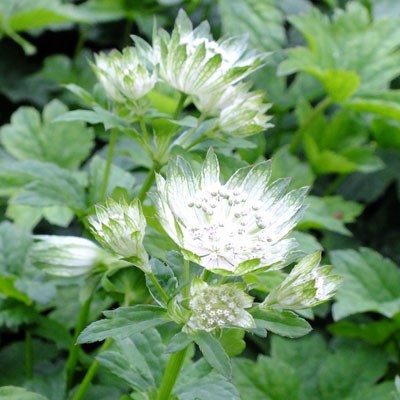
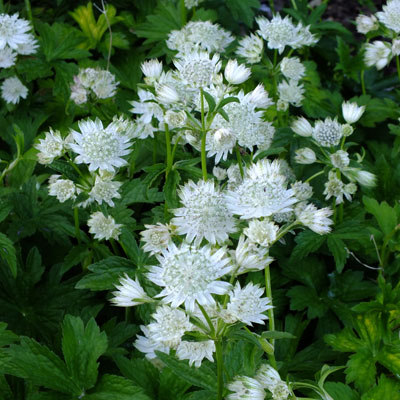
Potsize - 1L
A pure white, green-tipped, large flowered Astrantia from the 'Star' breeding program. We have examined this closely this year and it looks for all the world exactly like 'Shaggy', the excellent old variety selected by Margery Fish. It is a fine plant but we are as yet unsure why it merits its own name and PBR status.Links
Astrantia Compared
Astrantia in the Garden
Botanical Style Photographs
-

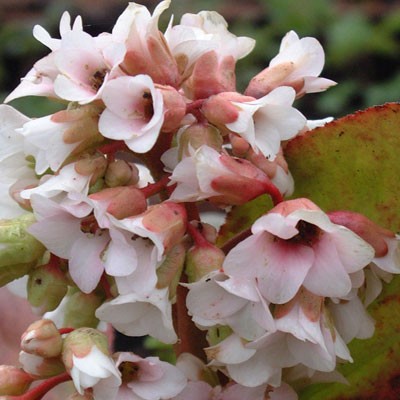
Potsize - 1L
Bergenia 'Bressingham White'. Praised for its robust stature and the freedom with which it produces both flower and leaf. Slowly spreading to form a good clump of large leaves with fine trusses of pure white flowers from March until May. Raised by Blooms and happy in both sun and part shade.Discount of 25p per plant for quantities of 3 or overLinks
Bergenia Compared
Botanical Style Photographs
-

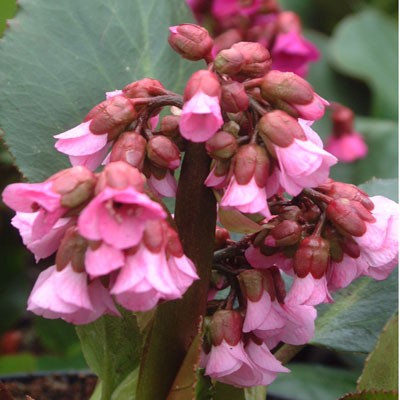
Potsize - 1L
Bergenia 'Eric Smith'. A handsome variety originally bred by Eric Smith at Hadspen House in Somerset and given to Beth Chatto who then named it in his honour. It has large, wavy edged crinkled leaves which take on plum and crimson tones in Winter. Sprays of bright mid-pink flowers top the foliage in Spring. Discount of 25p per plant for quantities of 3 or overLinks
Bergenia Compared
Botanical Style Photographs
-
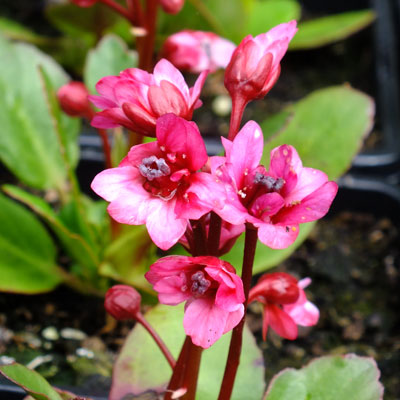

Potsize - 1L
This is a compact form of Bergenia but one that punches above its weight when it comes to flowering. Flowers are bright rosy-pink, carried on bright red stems and produced abundantly in March and April. Foliage is green for the growing season and turns deep beetroot in the Winter. 15-30cm tall. Discount of 25p per plant for quantities of 3 or overLinks
Bergenia Compared
Botanical Style Photographs
-
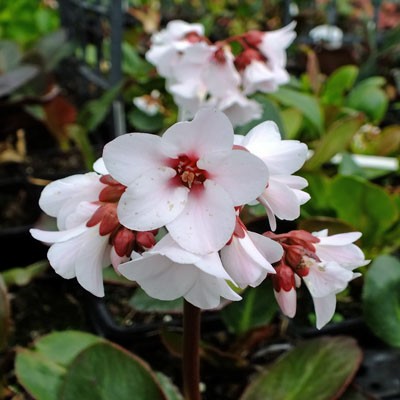

Potsize - 1L
An early flowering hybrid between B.ciliata and B.emeiensis nice, narrow, glossy green leaves, flushed red beneath and on the serrated margins. Like B.emiensis it has beautifully poised, shapely branched trusses of flowers, bell shaped at first becoming flared and wide separated with age. Also in common with B.emiensis its stems and calyxes are beautifully flushed with a pinky orange. The blooms are subtly shaded palest pink at first - just a suggestion of pink on a pure white, but as they age the central flush gradually grows until it is completely suffused rose-pink. A delightful but little known hybrid that requires a sheltered position away from the coldest winds. Bred by Robin White.Links
Bergenia Compared
Botanical Style Photographs
-
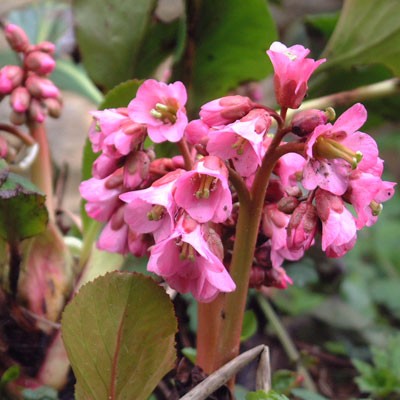
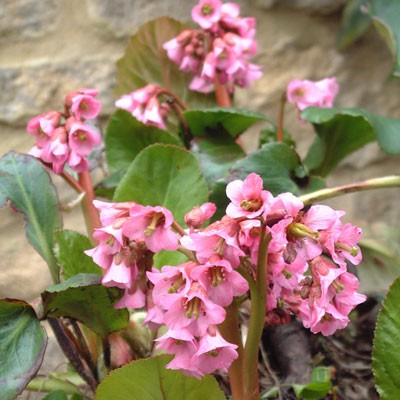
Potsize - 1L
Bergenia 'Silberlicht'. A relatively new addition to the Bergenia family having been raised in 1982 by H.Klose. It thrives in sun or shade even in quite dry conditions and produces valuable ground cover of handsome bronze tinted leaves. Its real beauty is shown when in flower late in the Spring. Flowering stems are tall and pink carrying flowers in a sugar pink hue. Discount of 25p per plant for quantities of 3 or overLinks
Bergenia Compared
Botanical Style Photographs
-
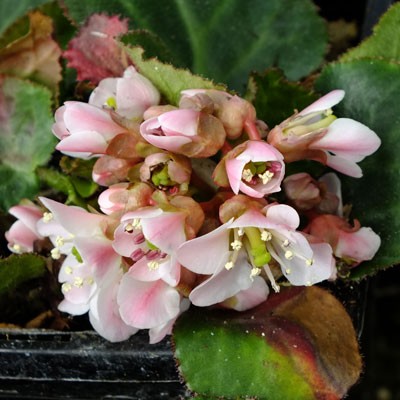
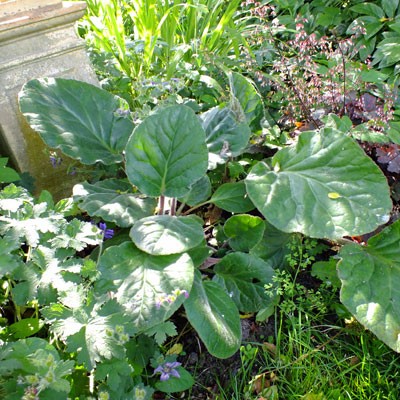
Potsize - 1L
Bergenia ciliata. The leaves of this choice species are large- up to 30cm across, well rounded and covered in tiny hairs. It makes a large clump, but considerably less dense than most bergenias. The flowers are pink, held erect and slightly fragrant. Slightly more tender than the more robust species and deserving of a spot with some shelter, especially for the flowers. Foliage will die back somewhat in winter. Leaves colour red in Autumn. Native of Afghanistan and Tibet. Prefers cool moist shade.Links
Bergenia Compared
Botanical Style Photographs
-
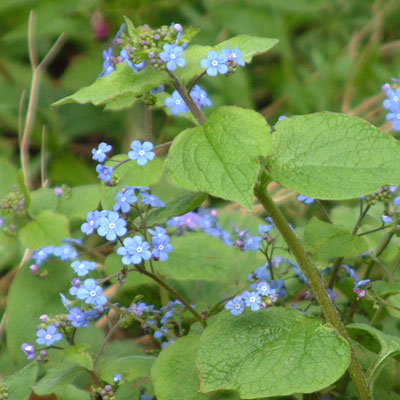
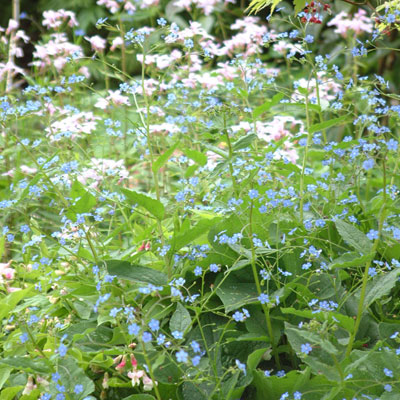
Potsize - 1L
Siberian Bugloss. A brilliant perennial which grows well in dry shady places, but will excel in most reasonable positions. Large heart-shaped felty green leaves make a stout clump topped in Spring with a cloud of tiny forget-me-not flowers. Hardy and reliable and one of those plants that ought to find a place in every garden. 30-45cmDiscount of 25p per plant for quantities of 3 or overLinks
Brunnera Compared
Botanical Style Photographs
-

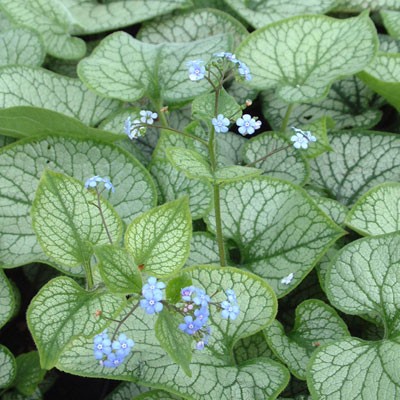

RHS AGM
Potsize - 1L
Brunnera macrophylla 'Jack Frost'. Coarsely hairy, heart-shaped leaves are heavily silvered and picked out by dark green margins and veins, making fascinating patterns not unlike an intricate cathedral window. A picture from Spring to Autumn especially when given shade and adequate moisture to prevent scorching in high Summer. The Spring display is further enhanced by an airy cloud of icy-blue forget-me-nots on stems decorated with smaller but similarly marked leaves. 50cmLinks
Brunnera Compared
Botanical Style Photographs
-
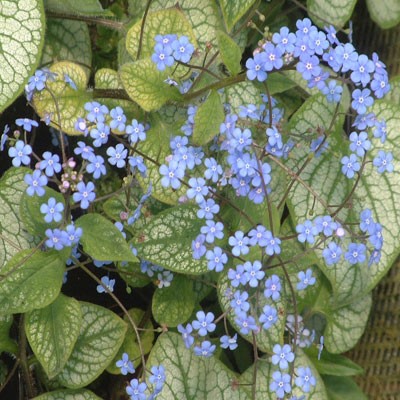
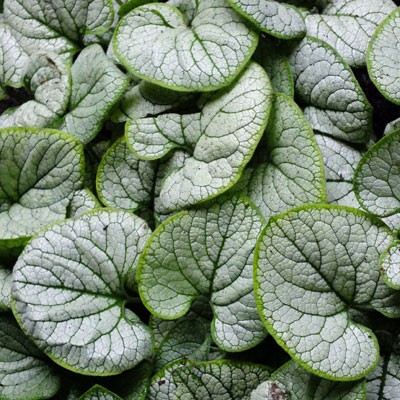
Potsize - 1L
Brunnera macrophylla 'Silver Heart'. A new introduction (2012) by Spilsbergen-Willemsen from the Netherlands. Superficially like a more silvered version of the popular Jack Frost, but generally considered to be a tougher more sun resistant variety on account of the thicker character of the leaves, which can also grow larger in size. Coarsely hairy, heart-shaped leaves are heavily silvered and picked out by dark green margins and veins, making fascinating patterns not unlike an intricate cathedral window. A picture from Spring to Autumn especially when given shade and adequate moisture to prevent scorching in high Summer. The Spring display is further enhanced by an airy cloud of icy-blue forget-me-nots on stems decorated with smaller but similarly marked leaves. 50cm plusLinks
Brunnera Compared
Botanical Style Photographs
-
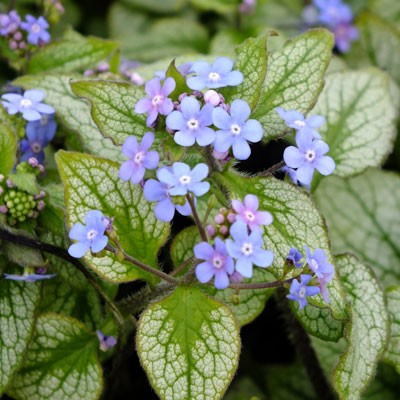
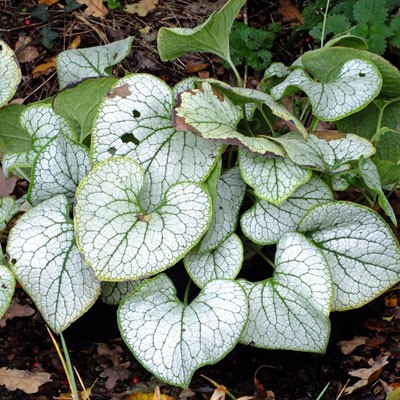
Potsize - 1L
Very similar to the ever popular Brunnera 'Jack Frost' except that it is a little whiter and has an elongated pointed tip to the leaf. Leaves are a lovely silver with the veins picked out in green forming a dense mound in any situation that is out of direct sun. Clouds of blue forget-me-not flowers in Spring.Links
Brunnera Compared
Botanical Style Photographs
-

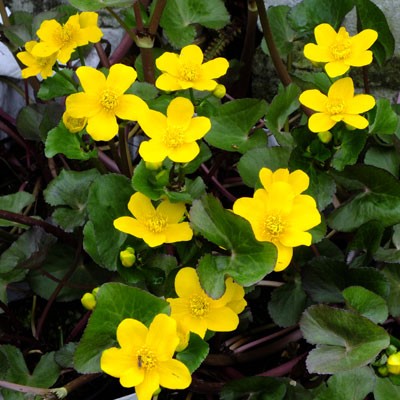

Bee Friendly
Potsize - 1L
A lovely variety with leaves that begin the year a rich bronze in colour. This colour fades as the flower stems develop so that by the time the plant is in full flower the leaves have toned down to a rich dark green with just the flower stems showing a purple flush. However the contrast of dark leaves and shining sunshine yellow flowers as they first emerge from the buds is a most beautiful thing. A variety that deserves to become well known. Marsh Marigolds are amongst the first flowers of Spring, flowering throughout the month of April.Discount of 25p per plant for quantities of 3 or over -
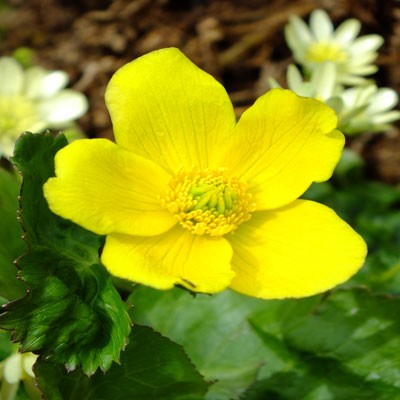
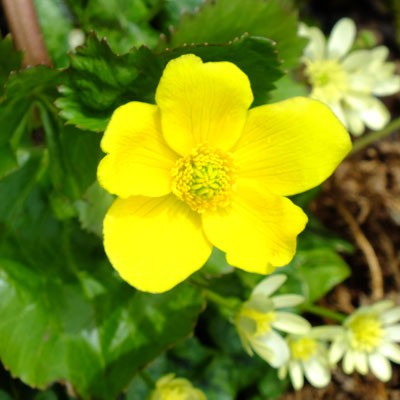

Bee Friendly
Potsize - 1L
There are two factors that set this lovely variety apart, its size and its colouring. It is larger than the species and perhaps a little more upright with leaves that are of a fresher paler green, held on pink stained petioles. The flowers, which are also large, are of a bright lemon yellow rather than the more chrome yellows of most varieties. Will root from the nodes on the flower stems. Can be planted on the pond margin or just into the water. 45cm. Marsh Marigolds are amongst the first flowers of Spring, flowering throughout the month of April. -
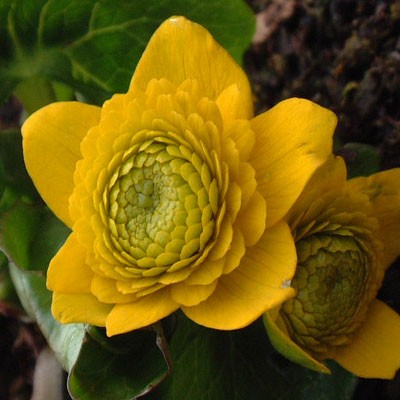
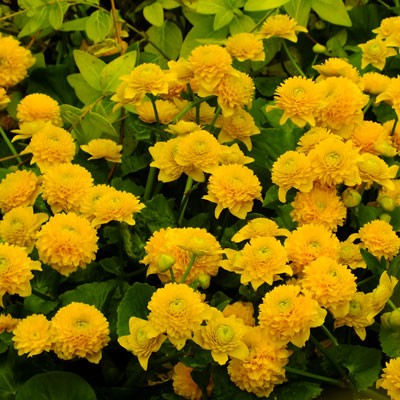

Bee Friendly
Potsize - 1L
As Marsh Marigolds go this one is relatively compact in growth, shorter in all its parts. However it is the flowers that are the chief attraction. They start off looking like a normal Marsh Marigold with the tightest anemone centre you could imagine. Then, as the flowers age, the centre petals grow out until you have a full blown miniature pom-pom dahlia of a flower in rich glowing gold. 30cm spread. Marsh Marigolds are amongst the first flowers of Spring, flowering throughout the month of April.Discount of 25p per plant for quantities of 3 or over -

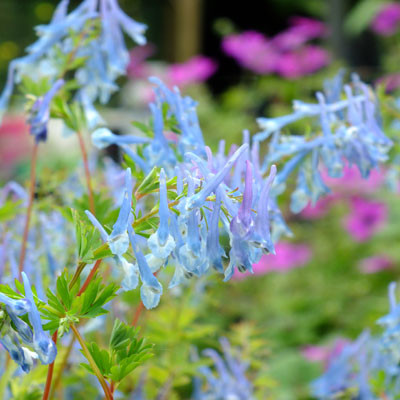
Potsize - 1L
A cross between Corydalis fleuosa and Corydalis omeniana from Ian Young's garden in Aberdeen. Vigorous clumps of limey, chartreusy-green juicy fern-like foliage over which come the strongly scented sky-blue flowers. Like Corydalis elata, but smaller and colouring only very slightly in the stems. Wintergreen and very hardy if grown in a moisture retentive soil which is not over wet and doesn't dry out in the Summer. Divide every three years to maintain vigour and encourage the best flowering. Flowers from Spring until June. 30cmLinks
Corydalis Compared
-
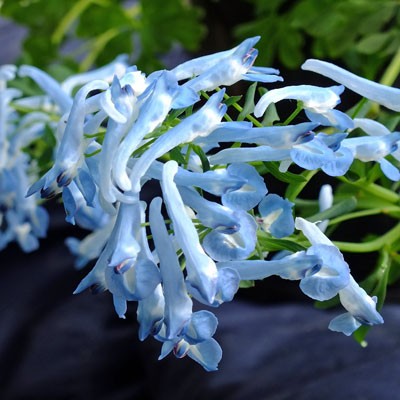

Potsize - 1L
A new repeat flowering variety with intense bright deep turquoise blue flowers that can appear from Early Summer right through until Autumn if moisture remains present. A hybrid of Corydalis flexuosa and Corydalis cashmeriana produced by Keith Lever. Short at 20-30cm. A short variety that retains the compact charm of C.cashmeriana but with a greater degree of vigour. Almost evergreen, taking on good colour in the flower stems with adequate moisture throughout the season.Links
Corydalis Compared
-
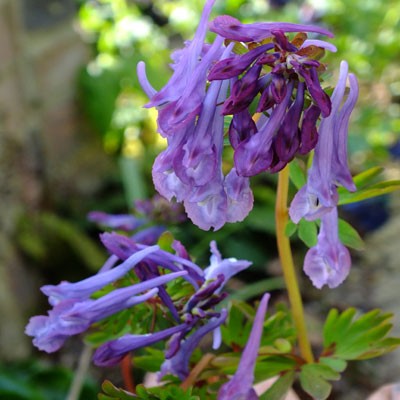

Potsize - 1L
Corydalis 'Spinners'. Distinguished by having flowers that age purple form a blue start earlier in the year. The flowering stems are pretty well upright and carry a distinctive red flush. The foliage mounds up into a ferny bush of fresh appley-green leaves which have a dusky cast in the winter from tiny brown spots. Early Spring. 30*30cm. For moisture retentive soil in shade or half shade. Possibly more evergreen than some.Links
Corydalis Compared
-

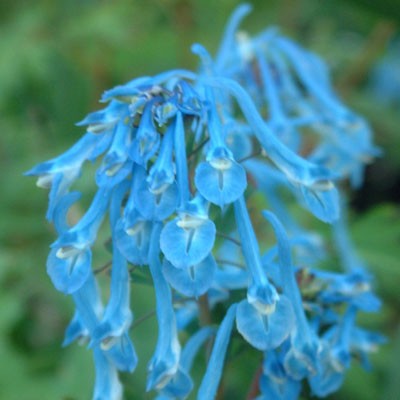
Potsize - 1L
Corydalis 'Tory MP'. This certainly has some Corydalis elata blood in it. The habit is fairly upright with the flowers being held high on tall stems and can come a month later than varieties such as Corydalis flexuosa 'Pere David'. They are a rich blue in colour. I did wonder if this earned its name on account of it being true blue and upstanding, then I read that it came from being true blue and going on and on! - but then again perhaps it owes something to its habit of disappearing from sight over the Summer ! - I'll leave you to draw your own conclusions. Early Spring. 45*30cm. For moisture retentive soil in shade or half shade.Links
Corydalis Compared
-



RHS AGM
Potsize - 1L
The beautiful Bleeding Heart or Lady-in-the-Bath. Fresh green ferny foliage above which arch stems dripping pink & white flowers like dewdrops. A picture of poise and grace. 3ft in a nice moist soil. The fleshy roots are delving and brittle so its best not disturbed and best sited in a sheltered situation in sun or partial shade with plenty of humus. In hot situations where water might go short at the roots, the plant will take a period of Summer dormancy but will re-emerge the following Spring. Mulching helps to extend the flowering season. Great cut flower and surprisingly scented. Deer and Rabbit resistant, possibly on account of its yellow sap. You know a plant has been loved for years when it has numerous names. For this one try Bleeding Hearts or Ladies-in-the-Bath, Ladies-in-a-boat or Dutchman's Breeches or even Lady's Locket and Lyre Flower. The ladies-in-the-bath/boat reference is only apparent if you take an open flower, turn it upside down and pull the outer petals apart, then it becomes obvious. Discount of 25p per plant for quantities of 3 or overLinks
Botanical Style Photographs

















































